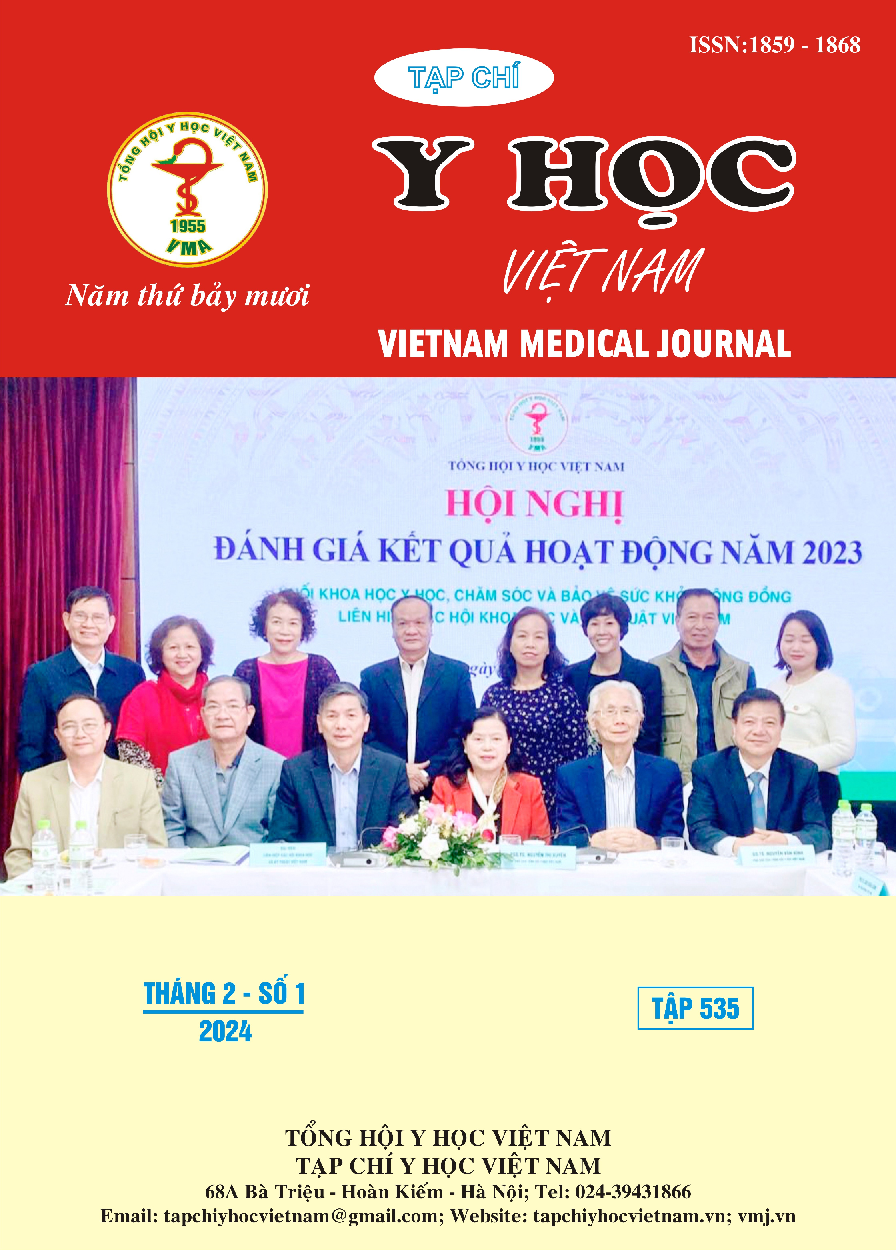EVALUATING THE RESULTS IN TREATMENT DISTAL TIBIA FACTURES BY OPEN REDUCTION AND INTERNAL FIXATION WITH LOCKING PLATE AT VIET DUC UNIVERSITY HOSPITAL
Main Article Content
Abstract
Objectives: We aim to evaluate the results of treatment of lower tibia fractures with locking screws at Viet Duc Friendship Hospital. Subjects and research methods: 55 patients (8 patients prospectively and 47 retrospective patients) underwent open surgery to fuse the internal bone of the lower end of the tibia with locking screws between January 2019 and the end of January 2023, at Viet Duc Friendship Hospital. Cross-sectional descriptive study with longitudinal follow-up combined retrospective and prospective. Evaluating the results of bone healing according to JL Haas and JY De la Caffinière, and rehabilitation results according to Olerud and Molander standards. Results: The average age of the study was 46.1 ± 14.9 years old with 25 female patients (accounting for 45%), 30 male patients (accounting for 55%). The most common cause is traffic accidents (67.2%), followed by daily life accidents (25.5%), and the lowest is occupational accidents (7.3%). Fracture grading according to AO/ASIF, group A1 fractures are the most common with a total of 18 cases (32.7%), followed by group C1 with 16 cases (29.1%). Groups A3 and C2 are the least common groups with rates of 10.9% and 3.7%, respectively. After surgery, the majority of cases (94.6%) had good and very good fracture reduction results according to JL Haas and JY De la Caffinière. Follow-up results after 6 months of surgery, 19.2% of patients had very good rehabilitation results, 34.6% had good results. The average rate of patients with rehabilitation results is 46.2%. No patient had a poor outcome. Conclusion: Bone fusion using locking screws to treat lower tibia fractures in adults brings relatively positive results: helping patients return to movement and activities soon, avoiding complications of muscle atrophy, joint stiffness, and malalignment.
Article Details
References
2. Zhou Y, Wang Y, Liu L, Zhou Z, Cao X. Locking compression plate as an external fixator in the treatment of closed distal tibial fractures. Int Orthop. 2015;39(11):2227-2237.
3. Haas JL., De la Caffiniere JY. Fixation of distal radial fractures: intramedullary pinning versus external fixation. In: Fracture of the Distal Radius. Lippincott Company; 1985:229-239.
4. Olerud C, Molander H. A scoring scale for symptom evaluation after ankle fracture. Arch Orthop Trauma Surg Arch Orthopadische Unf-Chir. 1984;103(3):190-194.
5. Nguyễn Mạnh Tiến. Đánh giá kết quả điều trị gãy đầu dưới xương chày bằng nẹp vít khóa tại Bệnh viện Hữu nghị Việt Đức. Luận văn thạc sĩ y học. 2015.
6. Phạm Vũ Anh Quang. Đánh giá kết quả điều trị kết hợp xương nẹp vít khóa xâm lấn tối thiểu gãy kín 1/3 dưới cẳng chân, trường Đại học Y Hà Nội. Luận văn thạc sĩ y học. 2022.
7. Liền xương, liền gân và dây chằng. In: Chấn Thương Chỉnh Hình. Nhà xuất bản Y học; 2004:164-173.
8. Nhân TT, Lai PH, Tấn NT. Đánh giá kết quả điều trị gãy đầu dưới 2 xương cẳng chân bằng phẫu thuật kết hợp xương nẹp khóa tại Bệnh viện Quân Y 121. Tạp Chí Dược Học Cần Thơ. 2021;(41):226-232.
9. Nguyễn TA, Nguyễn QH, Nguyễn VS, Hoàng VD, Nguyễn NS. Kết quả điều trị phẫu thuật gãy đầu dưới hai xương cẳng chân bằng kỹ thuật ít xâm lấn tại Bệnh viện Trung ương Thái Nguyên. Tạp Chí Học Việt Nam. 2021;502(1).
10. Phan Văn Ngọc, Lê Xuân Sơn, Hồ Sỹ Nam. Đánh giá phẫu thuật gãy đầu dưới xương chày bằng kỹ thuật ít xâm lấn tại bệnh viện Sài Gòn- ITO Phú Nhuận.2018.


